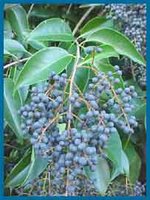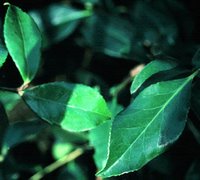 Hay-fever hell - it is Privet time (again)
Hay-fever hell - it is Privet time (again)
If you go to Bowral or Moss Vale at present, you will see large shrubs with masses of creamy heads of flowers growing all over the place. They are the Large-leaved Privet (Ligustrum lucidum) . This plant is a rampant weed in Sydney and warmer places. Here is a link to the Weed list of the Manly Council along with the list of Noxoious Weeds, and the action required of landholders. This plant is listed as a WB4 category, which means "Any existing weed must be prevented from flowering and fruiting".
*****
While Robertson is colder than other areas which this plant favours more, it does grow here, and it is a weed. It is closely related to the shrubbier, white flowered "Small-leaved Privet", which flowered heavily in Robertson in the first week of December. *****  This plant often survives in gardens because people mistake it for a Sasanqua Camellia. Its leaves are about the same size, but lack the small serrations on the edges of the leaves which Camellias generally have. It is more olive-green in colour than the Camellia, generally.
This plant often survives in gardens because people mistake it for a Sasanqua Camellia. Its leaves are about the same size, but lack the small serrations on the edges of the leaves which Camellias generally have. It is more olive-green in colour than the Camellia, generally.
 This plant often survives in gardens because people mistake it for a Sasanqua Camellia. Its leaves are about the same size, but lack the small serrations on the edges of the leaves which Camellias generally have. It is more olive-green in colour than the Camellia, generally.
This plant often survives in gardens because people mistake it for a Sasanqua Camellia. Its leaves are about the same size, but lack the small serrations on the edges of the leaves which Camellias generally have. It is more olive-green in colour than the Camellia, generally. *****
And of course, it never flowers like a Camellia. But if it is coming into flower now, with heads of masses of small, creamy flowers, then it sounds like it is the Privet. If so, please get rid of it. *****
As with the related plant, these plants are prolific seeders, and the birds love the seeds, and they are extremely fertile. This plant has the potential to grow to the size of a large tree, in Robertson. There was one which was removed from the school grounds, beside the School of Arts, last year, which was probably 15 metres tall, and had a trunk of nearly 1 metre diameter. A large tree, by any standards. And this is a definite weed, because of its prodigious ability to reproduce. (The foregoing link is to a New Zealand Website on noxious weeds. The "Tree Privet" as they call it, is obviously as much a problem for them as it is here. It is the same plant.)
*****
As with the Small-leaved Privet, these plants are a real headache for allergy sufferers, (quite literally). The heavy scent plays havoc with Hay Fever sufferers, blocking their noses and making their eyes water.
*****
If you have any of these plants growing on your property, it is reasonable to poison them right now, before they set maybe a million seeds for next year's crop of seedlings.
*****
Use the hole-drilling method. With a cordless drill, make a series of 6 mm (1/4 inch) holes around the stem, just into the bark - you don't have to go far in. Then pour in concentrated Glyphosate. You can use a small hatchet to cut a series of slashed cuts into the bark. Either way, apparently it is important to apply the poison immediately (within seconds of the cut being made). As usual, take "contact" precautions with herbicides - gloves, and masks, and wash thoroughly after using chemicals.

2 comments:
I loved Mim's comment on the greenhouse issue, that politicians obviously have a spare planet to go to, when this one is stuffed.
I wish they would leave now!
Working at the CTC this morning, I mowed under several large conifers. Deep underneath their lowest branches, where grass will not grow, for lack of light, were lots of seedling Privets. Happily growing in 90% shade.
They are a major problem in the Nature Reserve for this same reason - their ability to germinate and grow in really heavy shade.
This is how they get overlooked in gardens too, because they emerge from the middle of other shrubs, eg, Hydrangeas. And they are hard to remove when they are that big before you see them.
Post a Comment